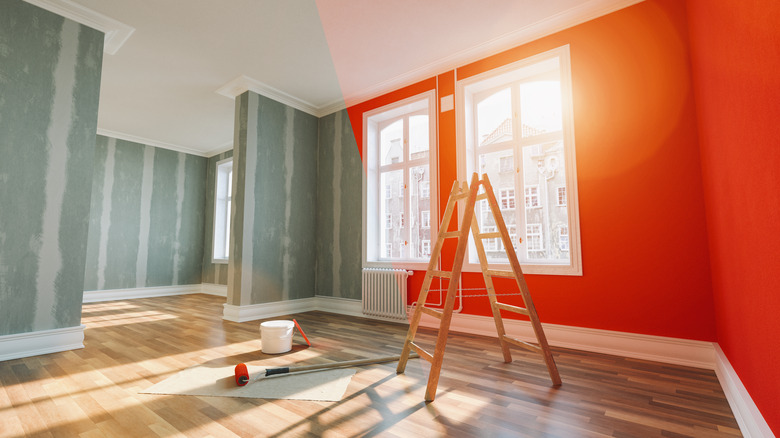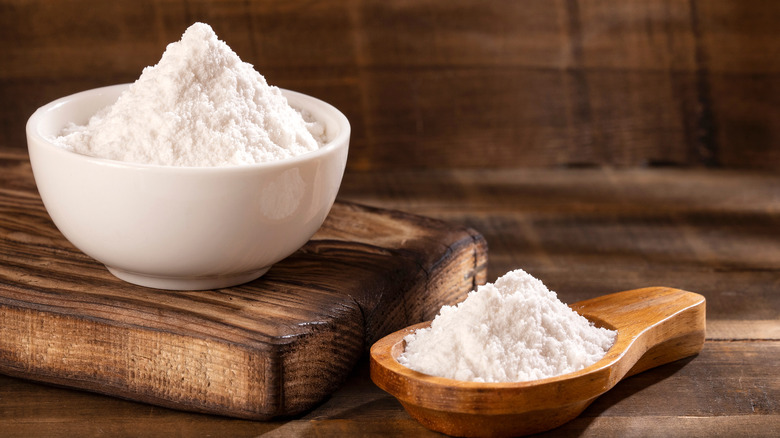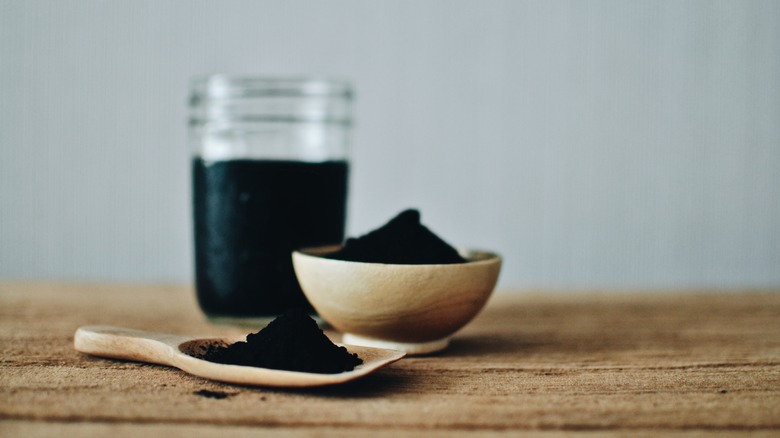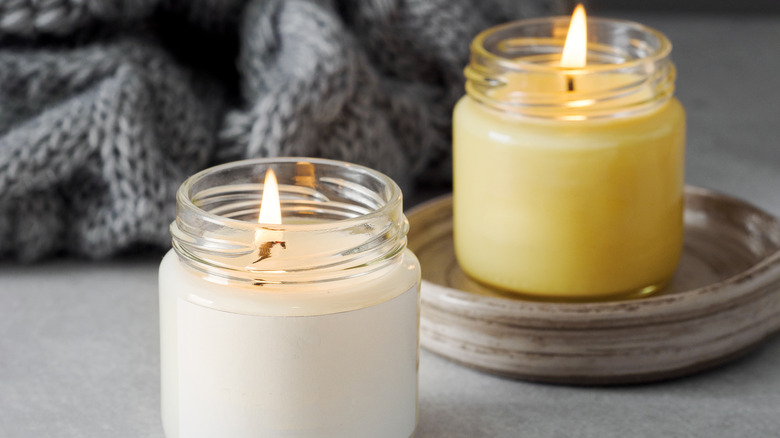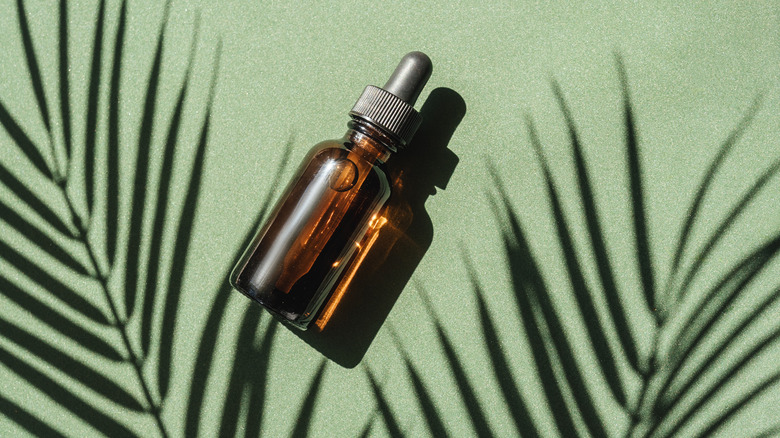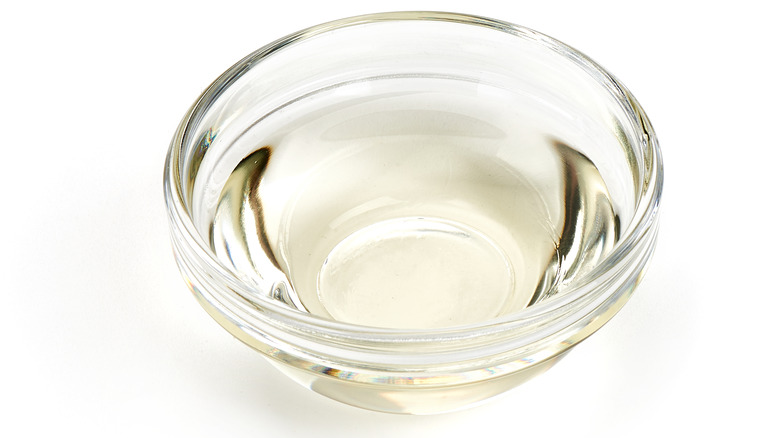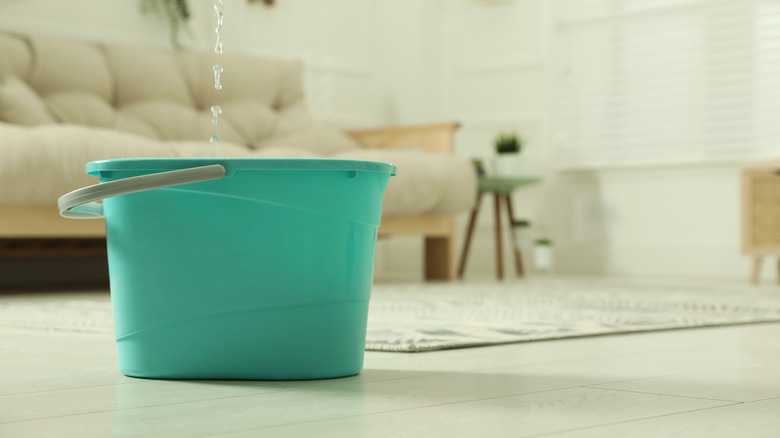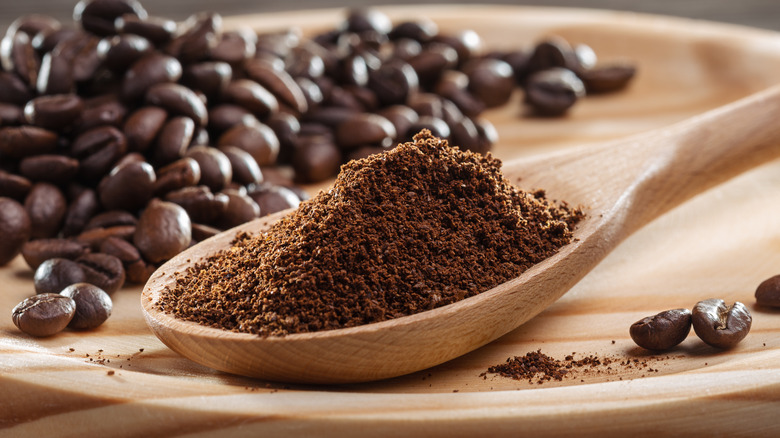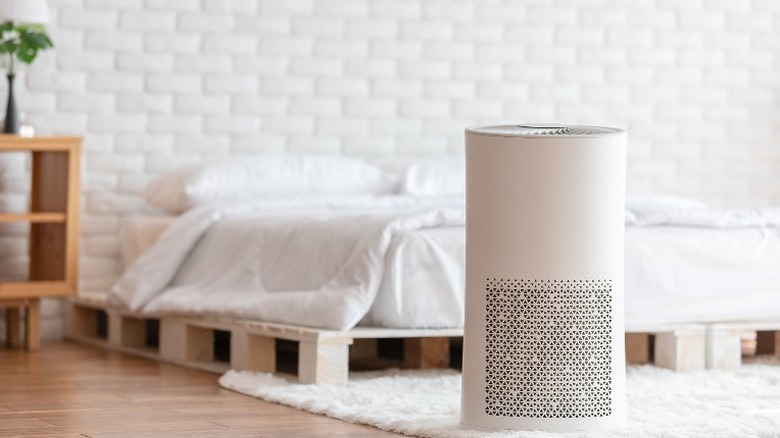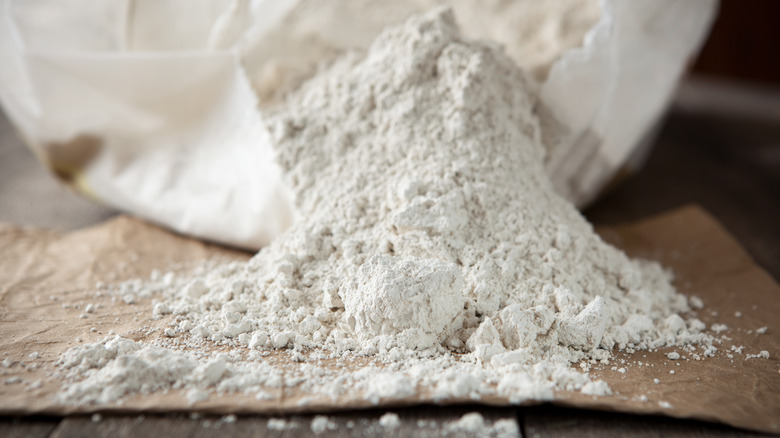11 Best Ways To Get Rid Of Paint Smell
As any DIY-er or interior design enthusiast will know, paint is one of the easiest, least expensive ways to completely transform a space. Even if you can't navigate power tools and don't quite have the budget to splurge on all new furniture or accessories for your space, you can splash on a fresh coat of paint in your selected shade and bring new life to a room. However, once you're done painting, there's one thing that no one wants lingering in the room: those awful paint fumes and smells. Sometimes, you're painting in more of an enclosed space like a bathroom, and it's tough to really get as much air flow as you might in a room with large windows. Other times, despite all your careful efforts, that smell just seems to linger. While you may absolutely adore the gorgeous hue you've covered the walls with, you find yourself avoiding that particular room for a few days just to avoid those headache-inducing fumes.
Luckily, you don't have to resign yourself to avoiding that space in your home or apartment for a month as you wait for the fumes to dissipate, according to Hunker. There are several tips and tricks that can be helpful in minimizing or starting to eliminate the aroma as long as you allow for time to do their thing. To that end, here are the eight best ways to get rid of paint smell.
1. Fans
Most people know that one of the best ways to prevent that paint smell from permeating the room you're working in is to keep things properly ventilated. Keeping the doors and windows in a room open can really help to avoid trapping in that paint smell. However, if you're painting a space that doesn't have that type of ventilation built in, or you just want to expedite the process, you may want to create your own ventilation system with some cleverly placed fans, suggests Country Living. You can put a few fans in the middle of the space you're painting and point them towards any exits, such as windows or doors, in order to try blowing those fumes out of there.
There's just one caveat with this method: Since you're getting all that smelly air circulating, you may want to ensure that the air vents are closed in the room and that you don't have your heating or air conditioning on, so you don't risk blowing that quickly circulating paint-scented air throughout the entire house. This is another reason to look at the weather forecast before busting open that paint can — even if you're indoors, it's best to paint on days where you can leave all your windows open and get that fresh, clean air flowing through your space.
2. Baking Soda
Chances are you have an opened box of baking soda stuffed somewhere in the back of your fridge, doing it's best to suck up all the unwanted and unpleasant food aromas that are wafting through the cool area. It turns out, you can apply that same principle to paint. For the low cost of a box of baking soda and very minimal effort, you can begin to combat that paint smell by simply pouring some baking soda into bowls and placing them around the room that you're painting, per The Spruce. This method of eliminating the odor can also be helpful for rooms that have a lot of furniture or something like carpeting, which tends to really soak in that scent in the air.
In addition to setting out bowls of baking soda to battle those fumes in the air, you can sprinkle the white powder over your carpeting, or even on any pieces of large furniture that you perhaps weren't able to move out of the room before painting, notes Country Living. Allow the baking soda to do its thing and just vacuum up the powder later, and hopefully enjoy your newly painted, less noxious space. Due to how gentle baking soda is, you don't have to worry about handling it as much as you would a chemical-packed alternative, and you can even leave the baking soda overnight in particularly smelly rooms.
3. Cut Onions
For this odor-eliminating hack, you'll have to head to your kitchen and grab a few onions. Yes onions, the same type you use for whipping up some of your favorite dishes. You may feel odd traipsing through your house with this ingredient that you more commonly use while making dinner than for DIY-provoked odor issues, but this hack apparently works like a charm. All you need to do is take at least two onions and slice them each in half, according to Service Sutra. Then, you can simply position the onion halves on a plate or in a bowl of some sort, with the layered cut-side facing upwards, and place that bowl or dish in the room you've just painted. The onions can then effortlessly work their magic and absorb some of those unpleasant smells floating through the room.
Obviously, once you feel like the paint smell in the room is under control and has been largely eliminated, you'll want to toss these powerhouse scent-suckers into the trash; they can potentially absorb some of the volatile organic compounds (VOCs) present in paint, so you definitely don't want them diced up in your bowl of post-painting chili (via Bob Vila).
4. Activated Charcoal
If you're a grilling enthusiast who firmly believes that charcoal is superior to gas grilling, you might have a few bags of charcoal briquettes laying around for your barbecue feasts. However, did you know that charcoal can be an absolute superstar when it comes to battling certain scents and odors? If you really don't feel like making a trip to the store and all you have on hand is the briquettes or charcoal you'd use for the grill, they're still better than nothing and can help absorb some of those paint fumes. However, for best results, get activated charcoal, as noted by the Atlanta Painting Company.
The powdered black mixture may not look like much, but since it's treated with high heat, it actually becomes even more porous and capable of absorbing all kinds of odor-carrying molecules in the air. All you need to do is pour the charcoal into a dish or pan of some sort, and leave it in the room you've just painted. The only thing to be careful with when using this scent-removing hack is to handle the charcoal with caution — as you may guess by the pigmented black hue of charcoal, it's capable of leaving some serious stains. To that end, you want to make sure you don't get any on your carpet or furniture (via Hunker), lest you be faced with removing stains as well as removing the paint smells.
5. Candles
If you're a huge candle lover who can never get enough of the gently flickering flame and variety of delectable scents, well, this is your time to shine. Burning a candle in a room filled with paint smells is a great hack for multiple reasons. First of all, it will get the aroma of whatever your candle is scented with throughout the space, the same as it would if you burned it anywhere else in your home. However, burning candles works in another way as well — although it's small, that dancing flame that adds ambience to the room also works to tackle those pesky volatile organic compounds (VOCs) floating through the air, burning them away, per Painter1.
While there are certain candles that have special odor-eliminating qualities, that's not a necessity for this hack — any candle you have at home will work. The candle will work double duty, filling the room with a pleasant scent while also working to absorb the unpleasant odors in the space, says Master Brush Painting. The only thing to be mindful of with this hack is safety; you want to ensure you're not leaving the candle unattended, lest you start a fire in your efforts to mask the paint smell.
6. Essential Oils or Extracts
Essential oils and extracts are known for their aroma, and it turns out they could be key in helping get that paint smell out of the space you've just revamped. And, if you're a fan of diffusing this aromatic ingredient, you just might have some of the most effective oils on hand, ready to use for this purpose. All you need to do in order to make this trick work is to dab a few drops of oil or extract on something like a cotton ball, and then place them throughout the room, preferably on a plate in order to avoid potentially staining soft furnishings like sofas or carpets, per The Spruce.
In terms of which oils to use, vanilla and peppermint are two of the best when it comes to refreshing the air in a room. Some other strong options are lemon, rosemary, lavender, and orange, all of which have their particular properties that could help add a particular ambience to your room as you work to eliminate the paint aroma, suggests Happy DIY Home. Some individuals even swear by the strategy of adding a few drops of oil or extract into the paint itself to help combat the scent from the very beginning (via Service Sutra).
7. Vinegar
While some people may have vinegar kicking around their pantry for cooking purposes, if you don't yet have vinegar on hand at all times to help with cleaning issues, you're missing out. The simple ingredient is a total powerhouse when it comes to eliminating particular things such as odors, which is why it's essential when trying to get rid of that noxious paint smell, according to Cleanipedia. All you need to do is fill a few bowls with this ingredient, place them throughout the room you've painted, and wait for the acetic acid in vinegar to neutralize those odor-carrying molecules, as noted by Country Living.
If you're trying to speed up the process, you may want to consider swapping out culinary vinegar with household vinegar, which has double the acetic acid percentage and thus can neutralize those odors at twice the pace. While white vinegar is typically considered the best option for eliminating those paint odors, you can try apple cider vinegar as well, if that's all you have on hand. As an added bonus, as with many of the other DIY solutions, this hack uses a non-toxic ingredient that you likely have available at home already, making it incredibly user-friendly and budget-friendly.
8. Water
When you're inhaling that strong paint smell after giving a room a fresh coat, it may seem like something as basic as water would be completely useless in battling the aroma. After all, it's just water, right? Well, it turns out, water is a bit of a superstar when it comes to absorbing all those fumes in the air, per Country Living.
As with other ingredients that manage to eradicate the paint smell in the air by absorbing it, all you really need to do is place a few buckets of water throughout the space (although filling pots or pans would work as well, in case you don't have an abundance of buckets on hand). Then, allow the water-filled vessels to hang out in the room for several hours, preferably overnight, and prepare to be amazed by this hack that was first included in "The Expert Cleaner," a volume published well over a century ago. If you want to level up this hack a little bit, you might also consider adding a few lemon slices to the water so that it offers a bit of a fresh citrus aroma in addition to merely absorbing the paint smell (via The Spruce).
9. Dry coffee grounds and coffee beans
Painters who relish the smell of coffee can use dry grounds or whole beans to combat the strong smells. It's effective because both contain nitrogen. This naturally occurring element is effective enough to absorb strong odors that come from sulfur and VOCs. In fact, it even works on raw sewage. There's also the bonus of the bad odors being replaced with a much more pleasant coffee smell.
After the painting is finished, get a few cookie sheets or other flat containers that are at least ¼-inch deep. These can be lined with parchment paper or another material so the trays can be easily cleaned afterward. Add a layer of coffee grounds or beans, say goodnight, and leave them sitting there until the next morning. The area will smell just like coffee when you wake up, but don't be tempted to reuse the grounds or beans to brew a cup of joe. That should be thrown away since they've absorbed the fumes.
10. An air purifier
A built-in HVAC air filter installed in a home system goes a long way toward maintaining interior air quality but many air purifiers are portable. Their internal fans draw in air particles, and built-in filters clean the air before it gets recirculated back into a room. They can be a convenient way to add a purifying boost in specific areas when more filtration is needed.
There are several categories of air filters and some are better suited for removing odors. Ones only made with mechanical filters are not, and others can produce harmful byproducts such as ozone. The best kinds for removing paint smells are made with HEPA and activated carbon filters. These have the ability to capture the airborne, odor-causing molecules in paint. When shopping for one, look for models that have different speed settings, Energy-Star certification, and low noise ratings. And for the best results, leave the purifier on until the paint smell is gone.
11. Diatomaceous earth
Many gardeners are familiar with diatomaceous earth, a pale, powdery substance made from fossilized remains that collect in sediment formed in bodies of water. It comes from microscopic, aquatic organisms known as diatoms or plankton. This powder is used to make natural pesticides and is typically safe when used properly inside your home as well.
The silica in diatomaceous earth has moisture and odor-absorbing qualities and can be set out in the same way as coffee grounds. But it's important to be careful because it can cause minor lung and skin irritation. Look for food-grade versions and stay out of the room when it's doing its work, keeping small children and pets away, too. The container used should also be tossed in the trash the next day, so opt for disposable ones. A 4-pound bag costs less than $15 and should be more than enough for one room.
